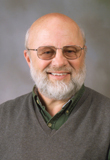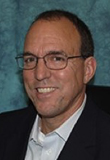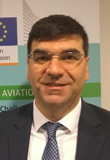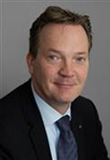|
Plenary Lectures
At least two plenary lectures per day are planned during SMART 2019. Efforts will be made to alternate industrial and academic invited speakers. Each plenary lecture will have a duration of 45 min (30+15 Q&A).
 |
Prof. D.J. Inman
Editor-in-Chief, Journal of Intelligent Material Systems and Structures
(Sage Pub.) University of Michigan, USA
Daniel J. Inman received his Ph.D. from Michigan State University in Mechanical Engineering in 1980 and is the C. L. “Kelly” Johnson Collegiate Professor and former chair of the Department of Aerospace Engineering at the University of Michigan, Since 1980, he has published eight books (on vibration, energy harvesting, control, statics, and dynamics), eight software manuals, 20 book chapters, over 350 journal papers and 600 proceedings papers, given 62 keynote or plenary lectures, graduated 64 Ph.D. students and supervised more than 75 MS degrees. He works in the area of applying smart structures to solve aerospace engineering problems including energy harvesting, structural health monitoring, vibration suppression and morphing aircraft. He is a Fellow of AIAA, ASME, IIAV, SEM and AAM.
Smart Structures for Bio-Inspired Morphing
|
 |
Prof. C. Lynch
Editor-in-Chief, Smart Materials and Structures (IOP)
Dean Bourns College of Engineering, University of California Riverside, USA
Prof. Lynch performed his MS, PhD, and Post Doctoral work at UC Santa Barbara. He joined the Woodruff School of Mechanical Engineering at Georgia Tech in 1995 and the Department of Mechanical and Aerospace Engineering at UCLA in 2007 where he served as director of the #2 ranked MS Online program and as the Mechanical and Aerospace Engineering department chair. On September 1, 2018 he moved to UC Riverside to serve as Dean of the Bourns College of Engineering.
Obtaining an Energy Function for Relaxor Rhombohedral Crystals and its use in Phase Field Modeling
|
 |
Prof. M. Ahmadian
Editor-in-Chief Journal of Vibration and Control (Sage Pub.)
Director Center for Vehicle Systems & Safety, Virginia Tech Blacksburg, USA
Mehdi Ahmadian is Dan Pletta Professor of Mechanical Engineering at Virginia Tech, where he also holds the position of Director of Center for Vehicle Systems and Safety (CVeSS), and the Railway Technologies Laboratory (RTL). Dr. Ahmadian has authored more than 400 refereed publications, and has made more than 300 technical presentations, including a number of keynote lectures. He holds 11 U.S. and international patents, and has edited four technical volumes. He currently serves as Editor for the International Journal of Vehicle System Dynamics and Editor-in-Chief for Journal of Vibration and Control. Dr. Ahmadian is Fellow of American Society of Mechanical Engineers (ASME), Fellow of the Society of Automotive Engineers (SAE International), and Associate Fellow of the American Institute for Aeronautics and Astronautics (AIAA).
Advancing Vehicle Safety through Smart Systems
|
 |
Dr. M. Kyriakopoulos
Senior Research Policy and Programme Officer Aviation Unit
European Commission DG R&I, Brussels, Belgium
Dr. Michael Kyriakopoulos serves the European Commission, as senior Research Policy and Programme Officer in the Aviation Unit of DG Research and Innovation (R&I). He contributes in setting the European Aviation research policy in the areas of competitiveness and environment. Overall, Dr. Kyriakopoulos puts all his energy in contributing to the European policies and priorities, for a strong and united Europe. He has 30 years of experience in aeronautics research. He graduated from the Mechanical and Aeronautical Engineering Department of the University of Patras (Greece). He earned his PhD in the Netherlands, focusing on computational methods for aerospace applications. Prior to DG R&I, Dr. Kyriakopoulos worked for the National Aerospace Laboratory (NLR), the Westinghouse Electric Company and the Institute for Advanced Materials of the Joint Research Centre. He has authored/co-authored 40+ scientific publications. He contributed to fundamental and industrial R&D in aeronautics in the areas of computational methods (with emphasis on coupled problems, FSI and MDO), design methodologies, composite aero-structures, impact dynamics, thermal barrier coatings, CMCs, manufacturing processes, and development of certification methodologies. Beyond aeronautics, Dr. Kyriakopoulos has also contributed and led Space (Rosetta/Philae landing gear), Defence and Energy industrial projects.
Achievements of 30 - years European Aeronautics Research and next Steps towards Horizon Europe
|
 |
Prof. F. Gandhi
RPI’s Aerospace Program Director
Director of RPI’s Center for Mobility with Vertical Lift (MOVE)
Farhan Gandhi is the Rosalind and John J. Redfern Jr. ’33 Endowed Chair in Aerospace Engineering at Rensselaer Polytechnic Institute (RPI) in the US. He is also RPI’s Aerospace Program Director, and Director of RPI’s Center for Mobility with Vertical Lift (MOVE). His research interest and activities cover the areas of rotorcraft aeromechanics, advanced rotary-wing configurations, multi-rotor aircraft, as well as smart/adaptive structures. Dr. Gandhi has been a visionary on reconfiguration in vertical lift platforms and high-speed rotorcraft and is credited with some of the most significant pioneering work in these areas with support from federal and state agencies as well as industry. He is a Technical Fellow of the American Helicopter Society, winner of the 1998 AHS François Xavier Bagnoud Award and the 2007 Popular Mechanics Breakthrough Award (for morphing rotors). He is a past Chair of the AHS Dynamics and Aircraft Design Technical Committees, and the AHS Education Committee. His research group at RPI comprises eleven PhD students, two post-doctoral research scholars, and a number of undergrad students. Dr. Gandhi is author of over 260 articles appearing in archival journals and technical conference proceedings.
Reconfigurable Vertical Lift
|
 |
Prof. R. Schweppe
Rainer Schweppe is the Head of the Department of Environmental Engineering at the Fraunhofer Institute for Chemical Technology (ICT) at Pfinztal, Germany.
Chair of the European Leaders platform "Eco Design" in the "Joint Undertaking" activity "Clean Sky – Greener Aviation" (www.CleanSky.eu).
Clean Sky is the biggest research program for the European Aviation industry. The objective is to reduce emissions and environmental impacts of airplanes during production & lifetime: CleanSky joins more than 900 actors from 24 countries (industrial & academic). The EcoDesign-Platform collects technologies which reduce the negative impact for the environment by using Life cycle assessment (LCA) methods. The Fraunhofer ICT developed a 100 % recycled seating cushion for the Airplanes containing a sustainable flame retardant system.
- Working in Cycles: Life-Cycle Assessment, recycling adequate product design (Eco-Design), recycling management. The research group for recycling and resource efficiency management develops raw material- and energy-optimized products and processes. Ecological and economic tools for a holistic evaluation of these processes in terms of their life cycle assessment (LCA) complete the portfolio of this group.
- Recycling of Phosphate in sewage sludge’s: New and resource-efficient processes are being developed to avoid the use of environmentally harmful substances and ensure the recovery of valuable raw materials.
- Biorefinery: To enable the use of renewable raw materials ICT develop biorefinery processes and evaluate them from a bio economic perspective. The biorefinery processes at Fraunhofer ICT include the feed materials wood, natural fats and oils, carbohydrates, and other biomass materials which do not compete with food production.
Clean Sky ecoDESIGN - Sustainable Developments for a Greener Aviation
|
 |
Dr. Johannes Riemenschneider
Acting head of Department of Smart Structures,
Institute of Composite Structures and Adaptive Systems,
German Aerospace Center (DLR), Braunschweig, Germany.
Dr. Johannes Riemenschneider is (since 2017) the Acting Head of the Adaptive System Department at the Institute of Composite Structures and Adaptive Systems of the German Aerospace Centre at Braunschweig, after beeing its Deputy Head (from 2009). In 2008, he got a PhD in Mechanical Engineering from Otto-von-Guericke-Universität in Magdeburg, while has there a Teaching Position since 2007 and Scientist position in the DLR-Institute of Composite Structures and Adaptive Systems. The fields of interest of Dr. Riemenschneider include adaptive composites and active twist rotors (design, manufacturing, testing of active twist rotors and smart rotor devices), morphing structures, smart materials (characterisation of piezoelectric actuators, integration of actuators, development of carbon nanotube based actuators), additive manufacturing (thermoplastic 3D printing, design of pressurized cells as actuators, integration methods for 3D printing).
Morphing for Aerospace and Wind Turbine Applications
|
|
|

